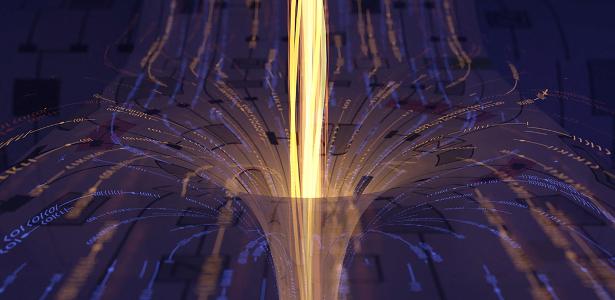In science fiction, wormholes in the universe act as portals through space-time through which spacecraft can easily traverse unimaginable distances.
Scientists have long sought a deeper understanding of this cosmic phenomenon, and on Wednesday they announced that they had managed to create two mini black holes that were simulated on a quantum computer and transmitted a message between them through the equivalent of a tunnel in space-time.
The achievement was obtained by a “miniature wormhole,” said Caltech physicist Maria Spiropolou, a co-author on the research published in the journal Nature.
She said humanity is still a long way from being able to send people or other organisms through portals like these.
“Experimentally speaking, for me, I’d say it’s way too long. People come up to me and ask, ‘Can you put your dog in a wormhole?'” “So no,” Spiropolo joked when answering reporters’ questions. “But this is a huge leap.”
“There is a difference between something that is possible in theory and possible in reality,” added physicist and co-author of the study Joseph Leiken of the US Fermilab Laboratory for Particle Physics and Accelerators.
“So you can sit back and wait for your dog to be sent through a wormhole. But we have to start somewhere. And I think it’s exciting that we can get our hands on this.”
The researchers observed the simulated wormhole dynamics in a quantum device from Google called the Sycamore quantum processor.
A wormhole – a rip in space and time – is a phenomenon that acts as a bridge between two remote regions of the universe. Scientists refer to them as Einstein-Rosen bridges, which are named after the physicists who described them – Albert Einstein and Nathan Rosen.
These wormholes are consistent with Einstein’s general theory of relativity, which focuses on gravity, one of the fundamental forces in the universe. Physicist John Wheeler coined the term “wormhole” in the 1950s.
The researchers found a quantum system that exhibits the key properties of a gravitational wormhole, Spiropolou said, but was small enough to be implemented on current quantum hardware.
“Here’s what we can say at this point: We have something that, in terms of the properties we observe, looks like a wormhole,” Lyken said.
The researchers said that no splits in space and time were created in physical space in the experiment, although a wormhole appeared that could be traversed based on quantum information teleported using quantum codes in a quantum processor.
“These ideas have been around for a long time and they are very powerful ideas,” Laikin said.
“But at the end of the day, we’re in experimental science, and we’ve been struggling for a long time with a way to explore these ideas in the lab. And that’s what’s really exciting. It’s not just, ‘Okay, wormholes are cool.'” “It’s a way of really looking at these fundamental problems of being in a lab environment.”

